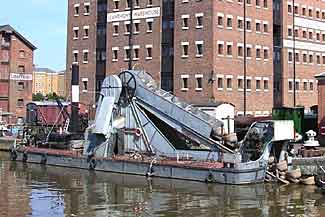Gloucester Docks & |
|
Museum Dredger and Sabrina 5 |
SND No 4 steam dredger was
built in 1925 for the Sharpness New Dock company by the De Klop
shipyard at Sliedrecht in Holland. (Another page features the earlier
dredgers used on the canal.) Supplied with SND No 4
were two pairs of clogs - one pair for the engine driver and the
other for the fireman, who would both be standing on oily plates
in the engine room. The boiler was originally coal fired but is
now fuelled by oil. It provides the power to drive the chain of
buckets, each of which can lift 7 cwt (356 kg) of silt. When the
bucket ladder was lowered to the required depth, the buckets scooped
up the mud on the canal bed and as the buckets turned over at the
top of their travel, the contents ran down a chute into a barge
moored alongside. As dredging progressed, SND No 4 was moved
sideways and forward by two steam winches on the deck which could
wind in or let out wire ropes, the ends of which were attached to
the canal banks. To move over long distances between dredging operations,
the dredger was towed by a tug. SND No 4 was mainly used
to dredge Gloucester Docks and the Sharpness canal to a depth of
16ft and to dredge the dock at Sharpness to 24ft. At times SND
No 4 also worked in the entrance and tidal basin at Sharpness.
These operations typically removed 35,000 to 40,000 tons of mud
from the canal and docks each year until 1981, when SND No 4
was replaced by a diesel-electric powered dredger. In 1988, SND No 4 became a working exhibit at the Museum, and visitors were able to watch demonstrations of the steam engine turning the buckets. Unfortunately, this role was interrupted in 1990 when a culvert failure down the canal caused a dramatic drop in dock water level and SND No 4 rolled over and sank. The dredger was raised by British Waterways staff, and then a long programme of clean-up and refurbishment was carried out by volunteer Friends of the Museum and Museum staff. SND No 4 is once again a working exhibit, operated and maintained by the Friends. Top
Sabrina 5 was one of six unpowered barges built in 1944 by Charles Hill & Sons of Bristol for the Ministry of War Transport. During the war, many ships were diverted from London to the west coast ports, and barges were needed to distribute the cargoes quickly. Initially they were managed by the Severn & Canal Carrying Co, and after nationalisation in 1948, they were operated by what became British Waterways. Towed everywhere by tugs, the barges were mainly used for carrying 130 to 150 tons of imports from Avonmouth to Worcester or Stourport via the Gloucester & Sharpness Canal and the River Severn. Each barge was crewed by two men, who shared a cabin in the stern under the wheelhouse. The principal cargoes were metals such as copper, zinc, steel and aluminium, and foodstuffs such as wheat, cheese, cocoa beans and tinned tomatoes. Dried fruit was fumigated while on board to kill off any parasites. Occasionally there was an outward cargo, and some trips were made to other ports in the Bristol Channel, but these were rare. The hold is covered by longitudinal hatch-boards supported on four rolling frames. When loading and unloading, these frames can be pushed along to the end of the hatch oipening to allow large items to be handled easily. The boards are covered by waterproof tarpaulins that are held in place by battens and wedges around the hatch combing, and strings are lashed over the top to stop the tarpaulins lifting. On one trip in 1949, Sabrina 5 was driven ashore west of Portishead when a tow-rope parted in a gale. The crew had to hang on for dear life as the barge crashed into the rocks several times before settling down, and they had to remain in their wheelhouse with waves breaking over them for about an hour before helpers appeared on the shore. Then lines were thrown to the helpers, and the men were able to scramble over the rocks through the breaking waves to safety. Sabrina 5 was refloated on the following day. In the 1960s, the barge traffic to the Midlands was adversely affected by the growing use of containers and lorries, and the barge fleet was formally disbanded in 1969, although some movements continued into the early 1970s. After several years of idleness, Sabrina 5 was restored at R W Davis & Son's yard at Saul, and in 1988 she became an exhibit at the Museum. In 2017, she was given a new role, as an access way was installed and her hold was converted to a meeting and education centre. For more information about the operation of these barges, see the Sabrinas page. |
 Steam
Dredger SND No 4
Steam
Dredger SND No 4 Barge
Barge